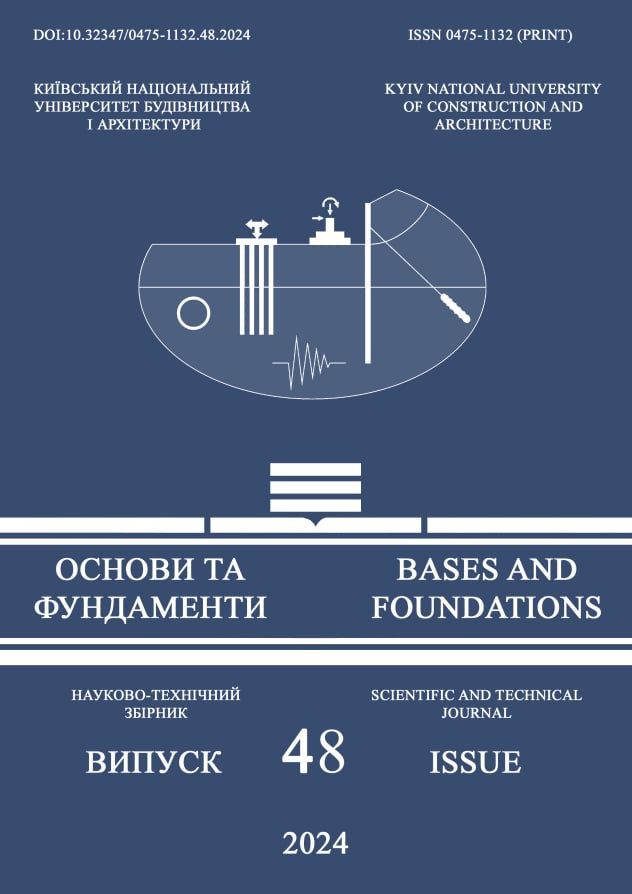Вплив методів деформування ґрунтової основи на формування напружено-деформованого стану підпірних стін
Основний зміст сторінки статті
Анотація
Представлено результати числового моделювання взаємодії пальової підпірної стіни з ґрунтовою основою за допомогою програмних комплексів «Plaxis» та «ЛІРА-САПР». Виконано порівняння напружено-деформованого стану підпірних стін при різних методах розрахунку з урахуванням наявності скельного ґрунту.
У першому варіанті значення активного тиску на стіну визначено вручну відповідно до актуальних норм [3], а подальший розрахунок виконано в ПК «ЛІРА-САПР». Роботу системи «паля – ґрунт» реалізовано за допомогою СЕ 57, які об’єднані між собою за допомогою СЕ 10 (стержень), а значення горизонтальних жорсткостей (Rx,y) визначено відповідно до вимог [3].
У другому варіанті розрахунок підпірної стіни виконано в ПК «Plaxis 2D». Модель поведінки ґрунтів — «Mohr-Coulomb», для скельного ґрунту — «Hoek-Brown». Враховано, що в основі підпірної стіни залягають скельні ґрунти, що виявило суттєві відмінності в розподілі згинальних моментів по довжині підпірної стіни.
Встановлено, що напружено-деформований стан у першому варіанті суттєво відрізняється від другого. Показано різницю максимальних горизонтальних переміщень після розрахунку за першою та другою методиками. Досліджено відмінності та різницю між значеннями згинальних моментів, що виникають у підпірній стіні. Показано важливість використання сучасних геотехнічних розрахункових програмних комплексів для більш детального та точного аналізу конструкцій та основ.
Додатково, проведено оцінку впливу варіацій параметрів моделі ґрунтів та підпірної стіни на результати розрахунків. Результати дослідження дозволяють рекомендувати використання комплексного підходу до моделювання для підвищення надійності та ефективності проектування підпірних стін. Проведений аналіз також показує, що застосування різних моделей поведінки ґрунту може суттєво впливати на кінцеві результати розрахунків, що підкреслює необхідність ретельного підбору параметрів моделювання.
Отримані результати мають важливе практичне значення для інженерів та проектувальників, оскільки дозволяють більш точно прогнозувати поведінку підпірних стін у різних умовах експлуатації. Це сприяє підвищенню безпеки та економічності будівельних проектів.
Блок інформації про статтю

Ця робота ліцензується відповідно до Creative Commons Attribution 4.0 International License.
Автори, які публікуються у цьому журналі, погоджуються з наступними умовами: Автори залишають за собою право на авторство своєї роботи та передають журналу право першої публікації цієї роботи на умовах ліцензії Creative Commons Attribution License, котра дозволяє іншим особам вільно розповсюджувати опубліковану роботу з обов'язковим посиланням на авторів оригінальної роботи та першу публікацію роботи у цьому журналі. Автори мають право укладати самостійні додаткові угоди щодо неексклюзивного розповсюдження роботи у тому вигляді, в якому вона була опублікована цим журналом (наприклад, розміщувати роботу в електронному сховищі установи або публікувати у складі монографії), за умови збереження посилання на першу публікацію роботи у цьому журналі. Політика журналу дозволяє і заохочує розміщення авторами в мережі Інтернет (наприклад, у сховищах установ або на особистих веб-сайтах) рукопису роботи, як до подання цього рукопису до редакції, так і під час його редакційного опрацювання, оскільки це сприяє виникненню продуктивної наукової дискусії та позитивно позначається на оперативності та динаміці цитування опублікованої роботи (див. The Effect of Open Access).Посилання
Аналіз існуючих методик розрахунку підпірних стін з буронабивних паль. / Д. Михайловський, О. Комар, М. Хоронжевський // Основи та фундаменти: Науково-технічний збірник. – К.: КНУБА. – 2023. – Вип. 46. – С. 88-97.
Hoek E, Carranza-Torres CT, Corkum B. Hoek-Brown failure criterion – 2002 edition. Proceeding of the 5th North American Rock Mechanics Symposium. Toronto, Canada, vol. 1, 2002, pp. 267 – 273.
Настанова з проектування підпірних стін: ДСТУ-Н Б В.2.1-31:2014 К.: Мінрегіонбуд України, 2015.
Основи та фундаменти споруд. Основні положення: ДБНВ.2.1–10:2018. – [ Чинний від 2019.01.01]. – К.: Мінрегіон України, 2018 – 36с.
Михайловский Д.В. Моделювання пальового фундаменту з використанням об'ємних фізично-нелінійних скінчених елементів грунту / Д.В. Михайловский, Д.М. Матющенко, А.О.Смоленський. // Науково-технічний журнал «Нові технології в будівництві». №29’15; Київ: НДІБВ, 2015. - С.44 - 52.
Городецкий А.С. Компьютерные модели конструкций / А.С. Городецкий, И.Д. Евзеров. – Київ: ФАКТ, 2007. – 392с.
Mykhailovskyi D., Komar O., Khoronzhevskyi M. (2023). Analiz isnuiuchykh metodyk rozrakhunku pidpirnykh stin z buronabyvnykh pal [Analysis of existing methods for calculating retaining walls from bored piles]. Osnovy ta fundamenty: Naukovo-tekhnichnyi zbirnyk. K.: KNUBA. Vyp. 46. S.88-97 (in Ukrainian).
Hoek E, Carranza-Torres CT, Corkum B. (2002). Hoek-Brown failure criterion – 2002 edition. Proceeding of the 5th North American Rock Mechanics Symposium. Toronto, Canada, vol. 1, pp. 267 – 273.
Nastanova z proektuvannia pidpirnykh stin [Guidelines for the design of retaining walls]: DSTU-N B V.2.1-31:2014 K.: Minrehionbud Ukrainy, 2015.
Osnovy ta fundamenty sporud. Osnovni polozhennia: DBNV.2.1–10:2018. – [ Chynnyi vid 2019.01.01]. – K.: Minrehion Ukrainy, 2018 – 36s
Mykhailovskyi D.V., Matiushchenko D.M., Smolenskyi A.O. (2015). Modeliuvannia palovoho fundamentu z vykorystanniam obiemnykh fizychno-neliniinykh skinchenykh elementiv hruntu [Modeling of the pile foundation using volumetric physically nonlinear finite soil elements]. Naukovo-tekhnichnyi zhurnal «Novi tekhnolohii v budi-vnytstvi». Kyiv: NDIBV, №2915, S.44 - 52.
Horodetskyi A.S., Evzerov Y.D. (2007). Kompiuternye modely konstruktsyi [Computer models of structures]. Kyiv: FAKT, 392s.
